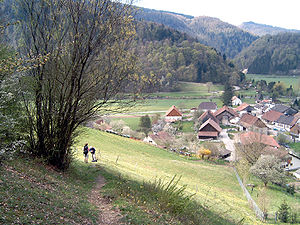| Revision as of 07:33, 20 March 2008 view source122.161.14.4 (talk) →Causes and consequences← Previous edit | Revision as of 07:34, 20 March 2008 view source 122.161.14.4 (talk) →Causes and consequencesNext edit → | ||
| Line 10: | Line 10: | ||
| ==Causes and consequences== | ==Causes and consequences== | ||
| {{seealso|Effect of sun angle on climate}} | {{seealso|Effect of sun angle on climate}} | ||
| |
The ] begins to warm significantly, causing new plant growth to "spring forth", giving the season its name. ] begins to melt, and ]s swell with runoff and spring rains. Most flowering plants bloom this time of year, in a long succession beginning even when snow is still on the ground, and continuing into early summer. In normally snowless areas, "spring" may begin as early as February during warmer years, with ] areas having very subtle differences, and ] ones none at all. ] areas may not experience "spring" at all until May or even June, or December in the outer ]. | ||
| ], ]]] | ], ]]] | ||
Revision as of 07:34, 20 March 2008
Spring is one of the four temperate seasons. Spring falls between winter and summer.
Dates

The Merriam-Webster Dictionary states that spring comprises "in the northern hemisphere usually the months of March, April, May, or as reckoned astronomically extending from the vernal equinox (March 20) to the June solstice (June 20).". The Southern Hemisphere experiences spring during the months of September, October, November.
The actual dates of vernal equinox vary depending on the year between March 19 and 21, those of the June solstice between June 20 and 21 on the Northern hemisphere and from September 19 to 21 and December 20 to 21 respectively on the Southern hemisphere.
Causes and consequences
See also: Effect of sun angle on climateThe hemisphere begins to warm significantly, causing new plant growth to "spring forth", giving the season its name. Snow begins to melt, and streams swell with runoff and spring rains. Most flowering plants bloom this time of year, in a long succession beginning even when snow is still on the ground, and continuing into early summer. In normally snowless areas, "spring" may begin as early as February during warmer years, with subtropical areas having very subtle differences, and tropical ones none at all. Subarctic areas may not experience "spring" at all until May or even June, or December in the outer Antarctic.



Severe weather most often occurs during the spring, when warm air begins to invade from lower latitudes while cold air is still pushing from the polar regions. Flooding is also most common in and near mountainous areas during this time of year because of snowmelt, many times accelerated by warm rains. In the United States, Tornado Alley is most active by far this time of year, especially since the Rocky Mountains prevent the surging hot and cold air masses from spreading eastward and instead force them directly at each other. Besides tornadoes, supercell thunderstorms can also produce dangerously large hail and very high winds, for which a severe thunderstorm warning or tornado warning is usually issued. Even more so than winter, the jet streams play an important role in severe weather in the springtime.
The hurricane season officially begins in late spring, on May 15 in the northeastern Pacific and June 1 in the northern Atlantic. Before these dates, hurricanes are almost unheard of and even tropical storms are rare, one of the earliest ever being Tropical Storm Ana in mid-April 2003. Even in June, hurricanes are uncommon because 21 of June's days are spring.
Spring is seen as a time of growth, renewal, of new life (both plant and animal) being born. The term is also used more generally as a metaphor for the start of better times, as in Prague Spring.
The first day of spring is the beginning of the new year, Nowruz, in the Iranian calendar and is celebrated in Iran (Persia) but also celebrated in Turkey (Turkiye) as Nevruz.
Nowrose or nowroze is not only celebrated in Afghanistan, Iran and Tajikistan but also amongst Kurd communities where ever they live. Also it is celebrated in Uzbikistan and all those places where Iranians (people belonging to encient Iran) from Sinkiang in China to Syria is celebrated as begining of the new year.
References
- "Spring". Merriam-Webster Dictionary. Retrieved 2008-02-18.
External links
- Word Lore
- Online Etymology Dictionary
- Glossary of Meteorology
- Solstice, Equinox & Cross-Quarter Moments for 2008 and other years, for several timezones
- Earth's Seasons, Equinoxes, Solstices, Perihelion, and Aphelion, 2000–2020 (from the United States Naval Observatory's Astronomical Applications Department)
- Seasons and Seasonal Cusps as Pagan and Religious Holidays (from Archaeoastronomy)
- What day does spring start? (BBC,UK News Magazine)
| Seasons | ||
|---|---|---|
| Temperate seasons | ||
| Tropical seasons | ||
| Specific | ||
| This article does not cite any sources. Please help improve this article by adding citations to reliable sources. Unsourced material may be challenged and removed. Find sources: "Spring" season – news · newspapers · books · scholar · JSTOR (February 2008) (Learn how and when to remove this message) |